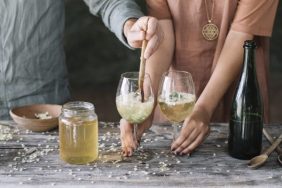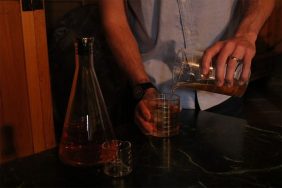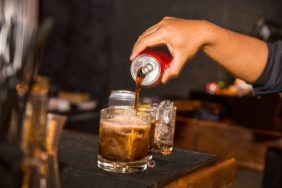Old Fashioned
No matter what bar you stroll into, from Los Angeles, to Dallas, to New York City, you’ll find a classic drink or two on their cocktail menu. In the simplest terms, classic cocktails aren’t disappearing anytime soon. Bartenders like them because they are usually fairly simple and allow them to use classic recipes. “Bartenders around the country are inventing creative concepts for classic cocktails in order to bring flavors forward,” says Michelle Gonzales, Director of Restaurants and Bars at Shadow Mountain Lounge in Aspen, Colorado. “We are seeing more bars and lounges in the scene stepping up to the plate by ‘re-inventing’ the classic cocktail.”
Making classic cocktails gets bartenders back to the roots of bartending, back to a time when drinks were simply done and didn’t require many ingredients (thus diluting the cocktail). “Some of the best cocktails only have a few ingredients that bring the cocktail together and enhance the flavors.” During prohibition, simple ingredients were focused on as the time to make a cocktail couldn’t be lengthy for worries of getting caught.
Classic Cocktails that are Making a Comeback
- The French 75 (Gin, Lemon, Sugar, Champagne)
- The Sidecar (Cognac, Cointreau, Lemon)
- Old Fashioned (Bourbon, Bitters, Orange, Cherry)
- Daiquiri (Rum, Simple Syrup, Lime Juice)
- Martini (Gin, Dry Vermouth)
Bartenders are updating classic drinks by using different types of bitters, caramelizing, and infusing, all of which enhance flavors. “It’s really fun to see what is coming forward as people get more and more creative.”
Gonzales believes one of the appeals of classic cocktails is how they are surprisingly approachable, simple to make, and great story tellers. “Join friends and challenge yourself to try a few and pass them around the table.”
Jeffrey Morgenthaler bartender at Portland’s Clyde Common and author of The Bar Book believes that a return to the classics was inevitable. “As people have been demanding more authenticity in their food, wine, beer, coffee, tea, etc., it was only a matter of time before we saw an increased interest in classic cocktails.”
He says that bartenders had had no choice other than to rise to the challenge of preparing authentic and delicious cocktails for their guests. “That’s how it works: lead, follow, or get out of the way.” It’s easy to substitute flavors into classic cocktails. “A drink calls for sugar syrup? Try it with honey or agave syrup.” Similar ingredients with different flavors can be swapped out when you know what you’re doing. “The list goes on.”
Christopher James, Head Bartender at Morristown, New Jersey’s Jockey Hollow Bar & Kitchen thinks that the return to “old timey” drinks stems from bartenders being classically trained before getting the opportunity to create cocktails. “When bartenders follow the golden ratios and their proper applications, they tend to innovate on what is tried and true and create better, more balanced cocktails.” Using these templates as a frame of reference is an easy way to educate and create.

The Sidecar
Bartenders are Embracing the Popularity of Classic Cocktails with Open Arms
“When given the opportunity to serve a ‘Dealer’s Choice’, I will nine times out of ten make them a classic I’ve been reading about.” He’s noticed that his fellow bartenders like to do the same.
Jockey Hollow has over fifty classic cocktails on their menu. “We do a progressive take on a Punch a la Romaigne which is very popular as well as our take on the Old Fashioned which is cedar smoked to order. It’s drinking theatre,” says James. Like many behind the bar, he feels many bartenders are getting fairly geeky and digging deep for more obscure recipes from ages past. “I’ve seen a few Old Pal riffs as well as some interesting riffs on the Scofflaw as of late.”
He’s seen a rise in bartenders updating classic drinks with modern flavors. At his bar, they do it by creating umbrella groups of ingredients and by making appropriate substitutions in their recipes. “It’s called the Mr. Potato Head principle on bartending. For example: you can take Solerno Blood Orange Liqueur, a product that was unavailable until a few years ago, and substitute it for Cointreau in a recipe.”
Matt Tocco, Beverage Director at Nashville’s famous Patterson House believes that there has been an increased interest in classic cocktails for the basic reason that they taste good without trying too hard. “They have survived the test of time for good reason.” He also thinks a lot of the excitement has to do with pop culture references to classic cocktails (“Mad Men”, “Crazy Stupid Love”, etc). “There are more and more places that are able to make good cocktails these days, and that never used to be the case,” says Tocco. “There has become a lot of value in them.”
The Patterson House is well known for its bartenders having their own takes on classic cocktails. “You’ll find our takes on drinks like a Dark & Stormy, or La Paloma.” They also use the framework from classics and tweak them even further with drinks like the Improved Vermouth Cocktail, Spring Sazerac, Pimm’s Cup Variations, and Polka Dot Negroni.

The French 75
How Bartenders Update Classic Drinks With Modern Flavors
- They change ratios and rebalance things to fit the modern day palate and modern day production methods of ingredients.
- They have a plethora of ingredients to use. “Today, there are so many different ingredients that are readily available,” says Tocco. “The world is so much more global and less localized.” This allows for more variations and interesting flavor combinations.
It’s important to remember that you don’t even need to visit a local bar to try a drink from a bygone era. You can easily make classic cocktails at home. “You don’t need a huge bar…a couple good bottles with fresh ingredients will go a long way.” You need to use good ingredients, but not necessarily the best ingredients. “A bottled in bond whiskey is typically always better for making cocktails than a twenty year old whiskey.” Also you can get great bottles for a reasonable price, so be cautious of advertising. “Remember that a large marketing budget doesn’t necessarily mean that something is good. Use your own judgment and always question their motives.”






